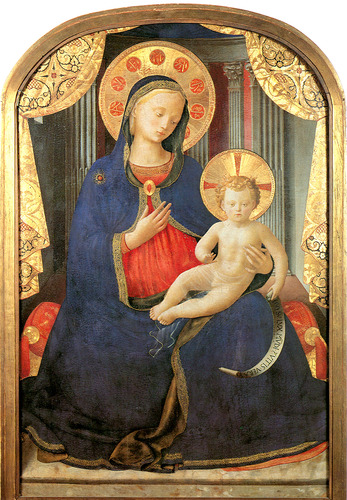
The Life of the Blessed Virgin Mary by Blessed Anne Catherine Emmerich
2.7 THE LIFE STORY OF TOBIAS. AN ALLEGORY OF THE COMING OF SALVATION.
[On the feast of the Archangel Michael in September 1821, Catherine Emmerich recounted, amongst other fragments of a vision of the holy angels, the following fragment of the story of Tobias, whom she had seen with the Archangel Raphael as his guide.]I saw many things from the life of Tobias, which is an allegory of the history of the coming of salvation in Israel; not an imaginative allegory, but one which actually happened and was lived. It was shown to me that Sarah, the wife of the young Tobias, was a prototype of St. Anne. I will relate as much as I can remember of the many things that happened, but shall not be able to reproduce them in their right order. The elder Tobias was an emblem of the God-fearing branch of the Jewish race, those who were hoping for the Messiah. The swallow, the messenger of spring, indicated the near approach of salvation. The blindness of old Tobias signified that he was to beget no more children, and was to devote himself entirely to prayer and meditation; it signified also the faithful, though dim, longing and waiting for the light of salvation and the uncertainty as to whence it was to come. Tobias' quarrelsome wife represented the empty and harassing forms into which the Pharisees had converted the Law. The kid which she had brought home in lieu of wages had, as Tobias warned her, really been stolen, and had for that reason been handed on to her in return for very little. Tobias knew the people concerned and all about it, but his wife only mocked him. This mockery also indicated the contempt of the Pharisees and formalists for the devout Jews and Essenes and the relationship between the two groups, but I cannot now remember how this was.The Archangel Raphael was not telling an untruth when he said that he was Azarias, the son of Ananias, for the general meaning of these words is: The help of the Lord out of the cloud of the Lord'. [40] This angel, the companion of young Tobias, represented God's watchfulness over the Blessed Virgin's descent through her ancestors and His preservation and guidance of the Blessing through the generations which preceded her conception. In the prayer of the Elder Tobias, and of Sarah, the daughter of Raguel (I saw both these prayers being brought by the angels at one and the same time before the Throne of God and there granted), I recognized the supplications of the God-fearing Israelites and of the Daughters of Sion for the coming of salvation, as well as the simultaneous prayers of Joachim and Anna, separated from each other, for the promised offspring. The blindness of the elder Tobias and his wife's mockery of him also symbolized Joachim's childlessness and the rejection of his sacrifice at the Temple. The seven husbands of Sarah, the daughter of Raguel, who were destroyed by Satan, came to their end through sensuality; for Sarah had made a vow to give herself only to a chaste and God-fearing man. These seven men symbolized those whose entry into Jesus' ancestry according to the flesh would have hindered the coming of the Blessed Virgin, and thus the advent of salvation. There was also a reference to certain unblessed periods in the history of salvation and to the suitors whom Anna had to reject that she might be united to Joachim, the father of Mary. The maidservant's reviling of Sarah ( Tob. 3.7) symbolized the reviling by the heathen and by the godless and unbelieving among the Jews against the expectation of the Messiah, for whose coming all God-fearing Jews were, like Sarah, inspired to pray with ever-increasing fervor. It was also an image of the reviling of Anna by her maidservant, whereafter that holy mother prayed with such fervor that her prayer was granted. The fish which was about to swallow young Tobias symbolized the powers of darkness, heathendom, and sin striving against the coming of salvation, and also Anna's long barrenness. The killing of the fish, the removal of its heart, liver, and gall, and the burning of this by Tobias and Sarah to make smoke--all these symbolized the victory over the demon of fleshly lusts who had strangled Sarah's seven husbands, as well as the good works and continence of Joachim and Anna, by which they had obtained the blessing of holy fruitfulness. I also saw therein a deep significance relating to the Blessed Sacrament, but can no longer explain this. The gall of the fish, which restored the sight of Tobias' father, symbolized the bitterness of the suffering through which the chosen ones among the Jews came to know and share in salvation; it indicated also the entry of the light into the darkness brought about by Jesus' bitter sufferings from His birth onwards.I received many explanations of this kind, and saw many details of the history of Tobias. I think the descendants of young Tobias were among the ancestors of Joachim and Anna. The elder Tobias had other children who were not godly. Sarah had three daughters and four sons. Her first child was a daughter. The elder Tobias lived to see his grandchildren.
CONTENTS | NEXT | FOOTNOTESCopyright ©1999-2023 Wildfire Fellowship, Inc all rights reserved

 Keep Site Running
Keep Site Running